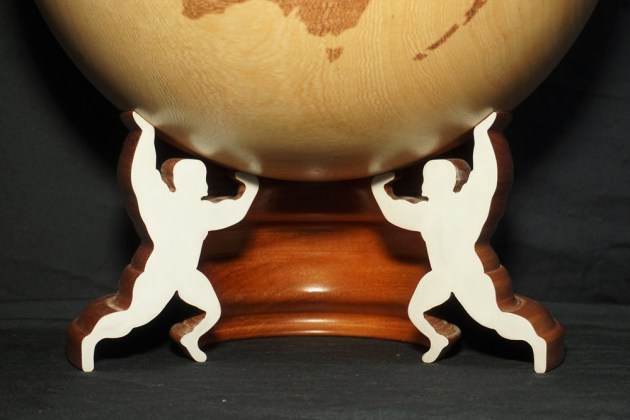Simon Begg: Making the "Weight of the World"
The diverse nature of entries for Maker of the Year presented by Carbatec is a unique opportunity to take a deep dive into some of the work presented. Simon Begg is a Sydney woodturner and woodcarver who creates work for galleries and markets, but also has an interest in the traditional technique of ring-turning. We asked Simon a few questions about the origins of this technique and about the process of creating his MOTY entry Weight of the World.
Ring-turning looks difficult! How do you figure out what a cross-section of a ring will look like? Do you use digital means?
The ring turning is quite a challenging technique as I don’t get to see the shape until I cut it to reveal the sections.
The key to a successful piece is the planning. This is all done on the computer using Microsoft paint and Word by finding and modifying a silhouette to match the idea or shape I want to reveal in the cut. It is then printed off fully to scale and that’s where I get my measurements.
There are a few ways to get the right shape but I work with a method that is like dot to dot with reference points. This is quite important for doing complex shapes with undercuts. When it comes to the turning side, its all done with normal tools like bowl gouges, detail gouges, parting tools, square end scraper, skew chisel and occasionally I will need small hooked scrapers.

The jacaranda spheres were turned in halves that were matched in diameter with the aid of a template before hollowing.
How long did it take to create the Weight of the World? Did you encounter any problems?
With all the work and varied techniques that went into Weight of the World, it took me about 25 hours. Most of my ring turnings are around the 5–6 hour mark but this one needed extra jigs, more complex templates and then needed the globe turned and image done. I didn’t want the globe to be too heavy so I chose to hollow it out.
I contacted an arborist friend of mine and he got me the jacaranda log that I was after. The day after the tree was felled, the two hemisphere bowls were roughed out and the microwaving process started to dry the blanks out. I got them fully dry after three days of rotations, totalling about 35 minutes each in 30 second bursts. After that I left them for a few weeks to equalise. When that was all done, I was able to turn the sections to create the globe. The ring turning took a full day to complete on the lathe. It was quite a relief when the bandsaw cut proved that day successful.
The main issue I had was with the image transfer. At first it was rediscovering the right combinations of inks and solvents. I settled on thinners with ink from a laser jet printer. Then my next issue was finding an image that transferred well onto a spherical surface. I ended up doing a few attempts, sanding off the ink until I got it right. Fortunately I didn’t have to redo the globe but there was a bit of trial and error along the way.

After hollowing, an inner lip was created to allow the perfect join required.
Can you give us a very brief history of ring-turning and explain how you became interested in it?
German ring turning is a 200 year old technique that was used for the production of toys, often carved animals. A large ring could be turned and then cut into 50 odd segments and they would all be the same base shape for quick chip carving. Nowadays with computer operated machines, this technique has disappeared, apart from a little bit done the Ore mountains in German that still has a bit of a folk art culture.
I treat the technique a bit differently leaving my rings in half or larger sections to keep the look of something that has been done on the lathe. In this way it becomes a sculptural piece rather than a production method. I have developed the technique to be able to get far more detailed shapes and more impressive silhouettes. I have also experiment with adding different timbers and even segmenting the rings to highlight my shapes. I got into the technique to challenge myself.
I have been turning full time for six years and a standard bowl is now second nature. These rings got me critically thinking about design, technique and turning to fine tolerances, often half a millimetre. It has actually greatly improved my other turning so I am really glad that I have run with the idea.

Above, left and centre: Stages in turning the base ring to the planned profile.
Above right: After the ring was complete a template was used to create the curve needed to seat the sphere.
Where did you learn your skills? What else do you make? Is this your full-time gig?
In a way, I’m self taught as I experiment a lot to find the processes and ideas that work best for me. However, like everyone, we draw influence from many others through demonstrations or observations made on photos of others works. I leant the basics at school which is when I bought my first lathe, and then after school I learnt my trade as a cabinetmaker. After going to Turnfest six years ago, I quit my job to do turning full time. I am very lucky to be able to do this full time.
Now I try to just stick to the turning and carving, mostly focused on the artistic side rather than production of spindles. When I am not turning the German rings, I am often working on bowls with carved embellishment inspired by nature or burls and unique timbers. I have now worked with 186 different species of timber.

Transferring the map of the world image to a spherical surfaces presented a few more challenges.
Where can people find more of your work?
I have a website, Facebook and Instagram to see photos of my current pieces. If you want to see my work in person, I do artisan markets around Sydney and have pieces in some of the wood galleries in NSW like Bungendore Wood Works, Leura and Sturt galleries.
See Simon Begg’s 2022 Maker of the Year entry here. See more of his work on his website and at Instagram @simonbeggswoodturning
Enter Maker of the Year presented by Carbatec at www.woodreview.com.au/moty2022
Earlybird entry pricing closes May 29.
MAJOR SPONSOR


SUPPORTING SPONSORS




